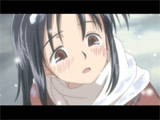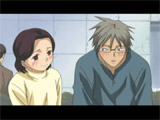

Quick Links:
Saishu Heiki Kanojo (Saikano), Episodes 8-10
The fourth volume of Saishu Heiki Kanojo turns what could've become a disjointed mess of ideas into a coherent story again. GONZO continues to deliver stunning visuals, and the bright colors of the characters' emotions can be seen clearly again. Volume 4 brings us through gut-wrenching heartache, but also offers a ray of hope.
Episodes 8-10 bring the story back into focus fully, which I had hoped they would. Episode 8, Minna Kawatte Iku (Everyone's Changing), follows in the vein of the previous volume with more side-stories involving secondary characters. Shuji and Akemi spend time together and talk about Atsushi, and Chise spends time with Tetsu, trying to feel like a regular girl again. In episode 9, Akemi, the town where all the characters live is hit by an earthquake, and the unit that Atsushi is fighting in gets attacked. The town will not be peaceful much longer. In episode 9, ...Soshite (And Then...), Fuyumi gets some bad news, and seeks comfort from Shuji. Shuji fights for his hometown in another way, when Akemi's little sister and her class wants to have a party. The volume ends on an up-note, with Chise returning to their town.
This volume returned to exploring Chise and Shuji's feelings in depth, which was a welcome and slightly overdue change. Chise continues to struggle with what it means to be alive, and what it means to be in love. Shuji is still trying to figure out how to be there for her, and for everyone he cares about. He shows what is perhaps the first sign of real growth when he helps Akemi's little sister. It's not quite enough to say that he has improved as a person, but it is almost touching. The three episodes in this volume are not without a hefty amount of sadness, though. The show is a very realistic and very graphic portrayal of war, and it reminds us of this regularly. Some might find its realism unsettling, especially in this volume. Luckily, the relatively light music helps lessen the impact of the heavy scenes a little. Overall, this volume returned to doing what I liked about the first few episodes: giving the characters' emotions the spotlight instead of their surroundings. As long as the final volume finishes with the same focus, it should be interesting.
The packaging for volume 4 suffers the same misfortune as the 3rd volume, having cover art which is only "okay", but having beautiful artwork on the insert. It's as if the distributor mixed up what was supposed to go on the cover with what was supposed to go inside. In this case, the insert sports a picture of Chise in the rain, with a sad look on her face and blood on her clothing. The cover shows Chise in the air, with wings spread out fully, and Tetsu on the ground holding a machine gun. Unfortunately, there were no nifty items accompanying the insert to distract me from my dissatisfaction with the cover, thus the presentation score has dropped slightly.
This volume of Saikano was surprising to me in a few ways, but the biggest was that it had attained a level of sadness that I thought only Grave of the Fireflies was capable of. On the other hand, its style is more like the numerous tragic tales of human greed and self-destruction seen many times througout literary history. Instead of trying to make a political statement, Saikano explores what's most important to living life, regardless of circumstances. The fourth volume has left me curious as to what lessons Takahashi has in store for the finale, and it has also made it easy for me to recommend this show with high regards.
Video Quality: A Audio Quality: A Presentation: B Content: A- Overall: A



